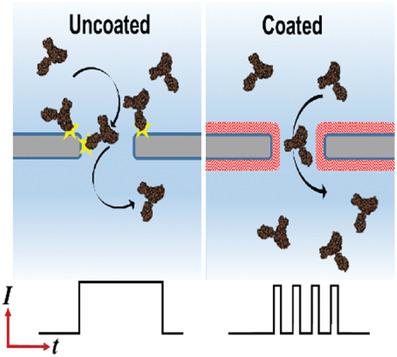当前位置:
X-MOL 学术
›
Small Methods
›
论文详情
Our official English website, www.x-mol.net, welcomes your
feedback! (Note: you will need to create a separate account there.)
Polymer Coatings to Minimize Protein Adsorption in Solid‐State Nanopores
Small Methods ( IF 10.7 ) Pub Date : 2020-07-16 , DOI: 10.1002/smtd.202000177 Saurabh Awasthi 1 , Pongsatorn Sriboonpeng 1 , Cuifeng Ying 1 , Jared Houghtaling 1 , Ivan Shorubalko 2 , Sanjin Marion 3 , Sebastian James Davis 3 , Laura Sola 4 , Marcella Chiari 4 , Aleksandra Radenovic 3 , Michael Mayer 1
Small Methods ( IF 10.7 ) Pub Date : 2020-07-16 , DOI: 10.1002/smtd.202000177 Saurabh Awasthi 1 , Pongsatorn Sriboonpeng 1 , Cuifeng Ying 1 , Jared Houghtaling 1 , Ivan Shorubalko 2 , Sanjin Marion 3 , Sebastian James Davis 3 , Laura Sola 4 , Marcella Chiari 4 , Aleksandra Radenovic 3 , Michael Mayer 1
Affiliation

|
Nanopore‐based resistive‐pulse recordings represent a promising approach for single‐molecule biophysics with applications ranging from rapid DNA and RNA sequencing to “fingerprinting” proteins. Based on advances in fabrication methods, solid‐state nanopores are increasingly providing an alternative to proteinaceous nanopores from living organisms; their widespread adoption is, however, slowed by nonspecific interactions between biomolecules and pore walls, which can cause artifacts and pore clogging. Although efforts to minimize these interactions by tailoring surface chemistry using various physisorbed or chemisorbed coatings have made progress, a straightforward, robust, and effective coating method is needed to improve the robustness of nanopore recordings. Here, covalently attached nanopore surface coatings are prepared from three different polymers using a straightforward “dip and rinse” approach and compared to each other regarding their ability to minimize nonspecific interactions with proteins. It is demonstrated that polymer coatings approach the performance of fluid lipid coatings with respect to minimizing these interactions. Moreover, these polymer coatings enable accurate estimates of the volumes and spheroidal shapes of freely translocating proteins; uncoated or inadequately coated solid‐state pores do not have this capability. In addition, these polymer coatings impart physical and chemical stability and enable efficient and label‐free characterization of single proteins without requiring harsh cleaning protocols between experiments.
中文翻译:

聚合物涂层可最大程度减少蛋白质在固态纳米孔中的吸附
基于纳米孔的电阻脉冲记录代表了单分子生物物理学的一种有前途的方法,其应用范围从快速的DNA和RNA测序到“指纹”蛋白。随着制造方法的进步,固态纳米孔正逐渐替代生物体的蛋白质纳米孔。然而,由于生物分子与孔壁之间的非特异性相互作用而减慢了它们的广泛采用,这可能导致伪影和孔堵塞。尽管通过使用各种物理吸附或化学吸附涂层通过调整表面化学来最小化这些相互作用的努力已经取得了进展,但仍需要一种简单,稳健和有效的涂覆方法来改善纳米孔记录的坚固性。这里,共价结合的纳米孔表面涂层是使用一种简单的“浸洗”方法由三种不同的聚合物制备的,并且就它们与蛋白质的非特异性相互作用最小化的能力进行了比较。已经证明,就最小化这些相互作用而言,聚合物涂层接近流体脂质涂层的性能。而且,这些聚合物涂层可以准确估计自由转运蛋白的体积和球形形状。未涂层或涂层不足的固态孔不具备此功能。此外,这些聚合物涂层可赋予其物理和化学稳定性,并能对单个蛋白质进行高效且无标签的表征,而无需在实验之间进行严格的清洁操作。
更新日期:2020-07-16
中文翻译:

聚合物涂层可最大程度减少蛋白质在固态纳米孔中的吸附
基于纳米孔的电阻脉冲记录代表了单分子生物物理学的一种有前途的方法,其应用范围从快速的DNA和RNA测序到“指纹”蛋白。随着制造方法的进步,固态纳米孔正逐渐替代生物体的蛋白质纳米孔。然而,由于生物分子与孔壁之间的非特异性相互作用而减慢了它们的广泛采用,这可能导致伪影和孔堵塞。尽管通过使用各种物理吸附或化学吸附涂层通过调整表面化学来最小化这些相互作用的努力已经取得了进展,但仍需要一种简单,稳健和有效的涂覆方法来改善纳米孔记录的坚固性。这里,共价结合的纳米孔表面涂层是使用一种简单的“浸洗”方法由三种不同的聚合物制备的,并且就它们与蛋白质的非特异性相互作用最小化的能力进行了比较。已经证明,就最小化这些相互作用而言,聚合物涂层接近流体脂质涂层的性能。而且,这些聚合物涂层可以准确估计自由转运蛋白的体积和球形形状。未涂层或涂层不足的固态孔不具备此功能。此外,这些聚合物涂层可赋予其物理和化学稳定性,并能对单个蛋白质进行高效且无标签的表征,而无需在实验之间进行严格的清洁操作。











































 京公网安备 11010802027423号
京公网安备 11010802027423号